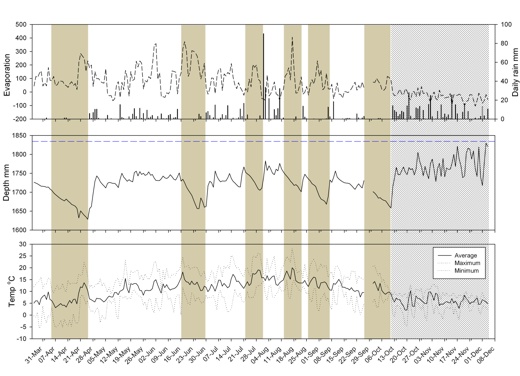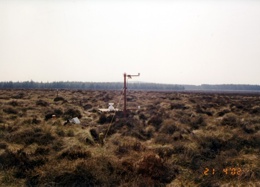
 |
 |
Preliminary assessment
In February 2002 a basic meteorological and hydrological station was installed in the centre of May Moss (Right). The station comprised two temperature and relative humidity (RH) (0.5 and 1.8m), soil temperature, wind-speed and direction (at 2 metres), photosynthetically active radiation and water table depth sensors. Precipitation was also recorded using a tipping-bucket rain-gauge. All recordings where completed on a 10 minutely average (temperature, RH, wind and radiation) or total (rainfall) basis between February and December in 2002. Temperature and RH where recorded at two heights to better understand the micro-meteorological structure near the ground and to allow estimation of evaporation. Two styles of water table behaviour are evident in the figure below, with during the winter months from 13 October the water table high and oscillating close to the surface. Conversely during the summer months from April to October there were a series of lowering events with water tables lowering by 25-30 cm, each terminating at a precipitation recharge event. The differences between summer and winter behaviour reflect the decline in evaporation and increased precipitation from October onwards. The summer behaviour is typical of ombrotrophic mires and shows that the water table is strongly coupled with precipitation.  Water loss from the mire is controlled in part by evaporation, but also surface and near-surface flow or run-off. This is shown by the April lowering of the water table, with no precipitation of noted throughout the month, but evaporation increases sharply on during the later part of the month and so the earlier gradual decline in water table probably reflects both run-off and evaporation. The water table during summer months is clearly controlled by a combination of precipitation, evaporative losses and run-off, but the run-off regime is unlikely to change throughout the year unless there were significant alterations to the drainage system and in 2002 there were not. |
 |